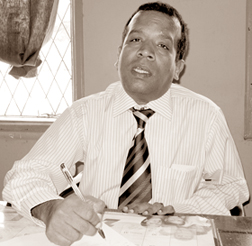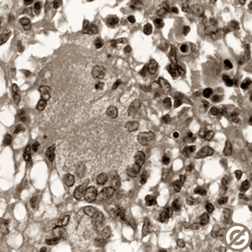
Public awareness vital to control TB
by Dhaneshi YATAWARA
|

Dr. Amitha Fernando, Consultant Chest Physician of the Colombo
Chest Clinic
|
|

World TB Day fell on March 24
|
Tuberculosis, an infectious disease caused by 'Mycobacterium
tuberculosis' is a disease that shook the world and made communities
vanish from the face of the earth. As the serious cases are very rarely
reported we think Tuberculosis or TB is eradicated. Yet one third of the
global population is infected with TB. This disease still remains a
major public health problem in Sri Lanka.
Over the years TB has killed billions worldwide. The disease bears
records even in ancient times. The germ has been found in Egyptian
mummies. It was on March 24, 1882 the bacteria 'Mycobacterium
tuberculosis' was discovered by Robert Koch. This breakthrough opened
paths for scientists to research on diagnosis and treatment for the
disease. And in 1943, Samuel Waksman discovered the powerful antibiotic
Streptomycin, a cure against TB.
Hundred years after Koch's discovery in commemorating this historical
event March 24 was declared as the World TB day promoting awareness on
the seriousness the disease posed to the world. The World Health
Organization declared TB a global emergency in 1993 and TB is the only
disease to be declared a global emergency.
Of the annual incidences of new cases of all forms - i.e. pulmonary
and extra pulmonary - 95% occur in the developing countries. Many TB
cases in developing countries remain undetected. TB is a leading cause
of death and disability among the economically active segment of the
population. Age specific prevalence of TB in developing countries show
that 75% of the cases are in the age group of 15 - 54 years, which are
the most productive years of life. This leads to disproportionate effect
on economic and social conditions due to both morbidity and mortality.
It kills more women than all causes of maternal mortality combined and
leaves more orphans than any other infectious disease.
This is still the commonest infectious killer of the world. Yet, TB
is a completely curable disease, said Doctor Amitha Fernando, Consultant
Chest Physician of the Colombo Chest Clinic. Therefore, prompt and
complete treatment will cure TB and it is the best way to prevent
further transmission of the disease in the community. "The highest
priority for TB control is the identification and cure of the infectious
cases - therefore the patients with sputum smear-positive Pulmonary
Tuberculosis," Doctor Amith Fernando said.
 Symptoms Symptoms
A cough which lasts for three or more weeks
Weight loss
Tiredness
Fever - rise in temperature especially in the evening
Night sweats
Chest pain
Shortness of breath
Loss of appetite
Coughing up blood stained sputum
People with Pulmonary TB are those who will be dispersing the
bacteria into the environment. They will be having one or more of the TB
symptoms.
"TB is related with many other factors - malnourishment, poverty,
socio economic conditions, living conditions, and over crowded dwellings
are some of these main factors. Marginalized communities, Internally
Displaced Persons, Prisoners, HIV positives are the sections facing more
risks in getting TB," Dr. Fernando said.
As 80% of the cases are infections in the lungs, Dr. Fernando says TB
infection and TB disease are two different cases.
A person will be disseminating the infection when he talks, coughs or
sneezes. The person is having the bacteria in his phlegm and sputum.
When a healthy person inhales this bacteria it gets into the lungs.
As Dr. Fernando explained most times the immunity of a person is
sufficient to contain the organism at that level and does not
necessarily get the disease. When the bacteria gets into the lung only
10% will develop the disease. The bacteria stay at a dormant stage.
"These people are not infectious because they do not dispose large
amounts - the bacteria is in their body either in the lung or at a
distant site - i.e. outer layer of lung, lymph nodes. It just lies
dormant," he added.
The Monteux test is done to detect this level of infection. There a
substance with the protein in the TB bacillus is injected under the skin
and if the person has been exposed to the bacteria his or her immune
system gets sensitive to this protein and reacts. A swelling or redness
could result in this area 72 hours later which we can measure. We can
only say that the person's immune system recognizes the TB bacillus and
the person does not necessarily have the disease.
Persons with weak immunity are categorized as risk groups who are
more prone to get TB. People can suffer weak immunity due to many
reasons. Diabetes, Kidney problems, being on strong medication for
cancer which suppresses the immune system, Asthma and chronic lung
diseases, those with already damaged lungs, Smokers and alcoholics,
abused drug addicts and HIV positives are more at risk.
Among male patients the majority are smokers and alcoholics, said Dr.
Fernando.
Treatment
"The TB bacillus causes destruction to the lung tissue and the blood
vessels making the patient cough with a little bit of blood. The lung
tissue heals but with a scar," said Dr. Fernando explaining the gravity
of neglecting TB.
"So, it is important to detect TB early to avoid heavy destruction to
the lung tissue. We can minimize the destruction to the lung, and also
limit the spread," he added.
|

Mycobacterium tuberculosis |
Directly Observed Treatment (DOT) is one of the important elements of
the internationally recommended strategy for TB control. DOT means that
an observer watches the patient take their tablets. This ensures that a
TB patient takes the right anti-TB drugs, and doses at the right
intervals without interruption and ensures that the patient completes
the full course of treatment.
"A newly diagnosed TB patient needs to undergo a continuous six
months treatment of a combination of drugs. Six months is minimum period
needed to fully cure the disease," he added.
According to Dr. Fernando there is another category - the
re-treatment cases. Here these patients are previously exposed to TB
medication and again diagnosed for TB. They will undergo a lengthy
period of treatment for nearly eight months.
"These drugs act on various stages of organisms. Some of the
organisms rapidly divide while others won't be so active. To achieve a
complete eradication it is essential to follow the full course of
treatment," he emphasized.
A patient must take all drugs prescribed for him within the
prescribed period because his disease is not yet cured even though he
might feel better. Treating TB consists of two phases - the initial
intensive phase and the continuation phase.
During the initial intensive phase, there is a rapid killing of the
TB bacilli. Patients quickly become non-infectious within about two
weeks and symptoms improve.
Most patients with sputum smear-positive TB becomes smear negative
within two months. DOT treatment is essential in the initial phase to
ensure that the patient takes every dose. Importantly this prevents
development of drug resistance. The risk of development of drug
resistance is higher during the early stages of anti-TB treatment.
The next phase - continuation phase - fewer drugs are necessary; But
for a longer period. The sterilizing effect of the drugs, eliminates the
remaining bacilli thus preventing subsequent relapses. Patients who have
taken anti-tuberculosis drugs previously are much more likely to develop
drug resistance which may have been acquired through inadequate prior
chemotherapy. Such patients require a stronger regimen consisting of
more drugs and for a longer period.
Today the world has become more complicated. "So, people tend to
spend more time in congested environments. People move into towns
looking for better opportunities.
So possibilities to get TB increase. Therefore, public awareness is
highly important," Dr.Fernando added.
"More than the disease it is the stigma that is associated with it
that is difficult to break.
It does not pass from generation to generation. Most of the time
people's image of a TB patient is of a wasted person which is not always
the case," Dr. Fernando said stating that it is time for us to correct
our thinking patterns.
Finding fitness: 10 ways to fit in exercise
******
The "E" word can make you cringe, but exercise is really
necessary. Besides, it can be fun: Learn how to squeeze fitness into
your busy day
*******
by Beth W. Orenstein
Medically reviewed by Pat F. Bass III, MD, MPH The benefits of
regular exercise are unrivaled: Physical activity can help you lose
weight and prevent a host of ailments, including heart disease,
diabetes, and osteoporosis. Being fit also can help you stay mentally
sharp. While most people know they should exercise, you may not know
where to start or how to fit it into a busy schedule. The American
College of Sports Medicine (ACSM) and the American Heart Association
(AHA) recommend that healthy adults get at least 150 minutes of
moderate-intensity aerobic activity spread out over five days a week, or
20 minutes of vigorous-intensity aerobic activity on each of three days
a week.
 "This
is something we recommend to all Americans," says Gerald Fletcher, MD, a
cardiologist at the Mayo Clinic in Jacksonville, Fla., and a spokesman
for the AHA. "This
is something we recommend to all Americans," says Gerald Fletcher, MD, a
cardiologist at the Mayo Clinic in Jacksonville, Fla., and a spokesman
for the AHA.
An ideal fitness routine also includes resistance or weight training
to improve muscle strength and endurance. The ACSM and the AHA recommend
that most adults engage in resistance training at least twice a week.
Finding Fitness: 10 Ways to Get in Exercise Sometimes the problem
isn't motivation - it's simply finding the time. But scheduling exercise
isn't as difficult as you might think.
Here are 10 ways to get you moving more often: Be less efficient.
People typically try to think of ways to make daily tasks easier. But if
we make them harder, we can get more exercise, says Sabrena Merrill, MS,
of Lawrence, Kan., a certified personal trainer, group fitness
instructor, and spokeswoman for the American Council on Exercise (ACE).
"Bring in the groceries from your car one bag at a time so you have to
make several trips," Merrill says. "Put the laundry away a few items at
a time, rather than carrying it up in a basket."
Shun labor-saving devices. Wash the car by hand rather than taking it
to the car wash. "It takes about an hour and a half to do a good job,
and in the meantime you've gotten great exercise," Merrill says. Use a
push mower rather than a riding mower to groom your lawn.
Going somewhere? Take the long way. Walking up or down a few flights
of stairs each day can be good for your heart. Avoid elevators and
escalators whenever possible. If you ride the bus or subway to work, get
off a stop before your office and walk the extra distance. When you go
to the mall or the grocery store, park furthest from the entrance, not
as close to it as you can, and you'll get a few extra minutes of walking
- one of the best exercises there is, Dr. Fletcher says.
"Walking is great because anyone can do it and you don't need any
special equipment other than a properly fitting pair of sneakers."
Be a morning person. Studies show that people who exercise in the
morning are more likely to stick with it.
As Merrill explains, "Are you going to feel like exercising at the
end of a hard day? Probably not. If you do your workout in the morning,
you're not only more likely to do it, but you'll also set a positive
tone for the day."
Ink the deal. Whether morning, afternoon, or evening, pick the time
that is most convenient for you to exercise and write it down in your
daily planner. Keep your exercise routine as you would keep any
appointment.
Watch your step. Investing in a good pedometer can help you stay
motivated. "If you have a pedometer attached to your waist and you can
see how many steps you've taken, you'll see it doesn't take long to walk
5,000 steps and you will be inspired," Merrill says. And building up to
10,000 steps a day won't seem like such a daunting a task.
Hire the right help. While weight training is important, if you don't
know what you're doing, you run the risk of injuring yourself or not
being effective, Merrill says. It's best to get instructions from a
personal trainer at the gym. You also can buy a weight-training DVD and
follow along in your living room.
Keep records. Grab a diary or logbook, and every day that you
exercise, write down what you did and for how long. Your records will
make it easy for you to see what you've accomplished and make you more
accountable. Blank pages? You'd be ashamed.
Phone a friend. Find someone who likes the same activity that you do
- walking in the neighborhood, riding bikes, playing tennis - and make a
date to do it together. "Exercising with a friend or in a group can be
very motivating," Fletcher says.
"You are likely to walk longer or bike greater distances if you're
talking to a friend along the way. The time will go by faster."
Don't have a buddy who is available? Grab an MP3 player and listen to
your favorite music or an audio book while exercising.
Do what you like. Whatever exercise you choose, be sure it's one that
you enjoy. You're more likely to stick with it if it's something you
have fun doing rather than something you see as a chore, Fletcher says.
If you can't fit 30 minutes a day into your schedule, get more
exercise simply by being less efficient with your chores and adding a
little extra walking distance everywhere you go.
However, if you pick an activity you like, finding time for fitness
will become effortless and the rewards enormous.
Seven foods that fight fat
by Shaun Chavis
Want to get more bang for your bite? These foods do double duty-they
help you blast fat and make you feel full longer, so you'll eat fewer
calories.
Eggs
 78 calories each An egg's not only a nutritional powerhouse, it's
also loaded with protein that satisfies. Eat eggs for breakfast; they'll
curb your appetite enough that you'll have about 330 calories less than
usual throughout the rest of the day. 78 calories each An egg's not only a nutritional powerhouse, it's
also loaded with protein that satisfies. Eat eggs for breakfast; they'll
curb your appetite enough that you'll have about 330 calories less than
usual throughout the rest of the day.
Bonus tip: For a healthy fried egg, brush a nonstick skillet with a
smidge of oil or cooking spray. You'll get crispy edges without much
fat.
Dark chocolate
170 calories for 1 ounce.
Just one more reason to indulge: nosh on dark chocolate and you'll
eat less at your next meal, according to research from the University of
Copenhagen.
Why? Compounds in chocolate slow down digestion and make you feel
full longer. A small piece of chocolate (aim for the size of a business
card) can also curb your cravings for salty, sweet, and fatty foods.
Pine nuts
95 calories for 1/2 ounce (about 84 nuts).
Move over almonds! The heart-healthy fatty acids in pine nuts boost
satiety hormones that make you feel full, according to Korean
researchers. The same fatty acids also keep belly fat at bay.
Cheese
76 calories for 1 ounce Go. for fresh goat cheese or feta for a dose
of conjugated linoleic acid (CLA)-it helps you feel full and burn more
fat. Cheeses from grass-fed animals have the most CLA, so buy ones
labeled "grass-fed."
Skimmed milk
86 calories for 1 cup.
Most of us think of milk as kids' stuff, but it boasts grown-up
benefits. Milk's proteins (whey and casein) can make you feel more
satisfied than sugary drinks. CLA in milk fights fat, too.
Oranges
59 calories each.
An orange is one of the most satisfying grabs from the fruit
bowl-thanks to all that fiber. Oranges were the highest-ranked fruit on
the "satiety index," a list of 38 filling foods put together by
Australian researchers. And fiber fights fat: people who eat more fiber
have less flab.
Potatoes
161 calories each.
High-carb spuds often get a bad rap, but they deserve to be a
dieter's BFF. Three times as filling as a slice of white bread, potatoes
top all of the foods on the satiety index. Plus, the resistant starch in
potatoes help your body burn fat, too.
- CNN
|

